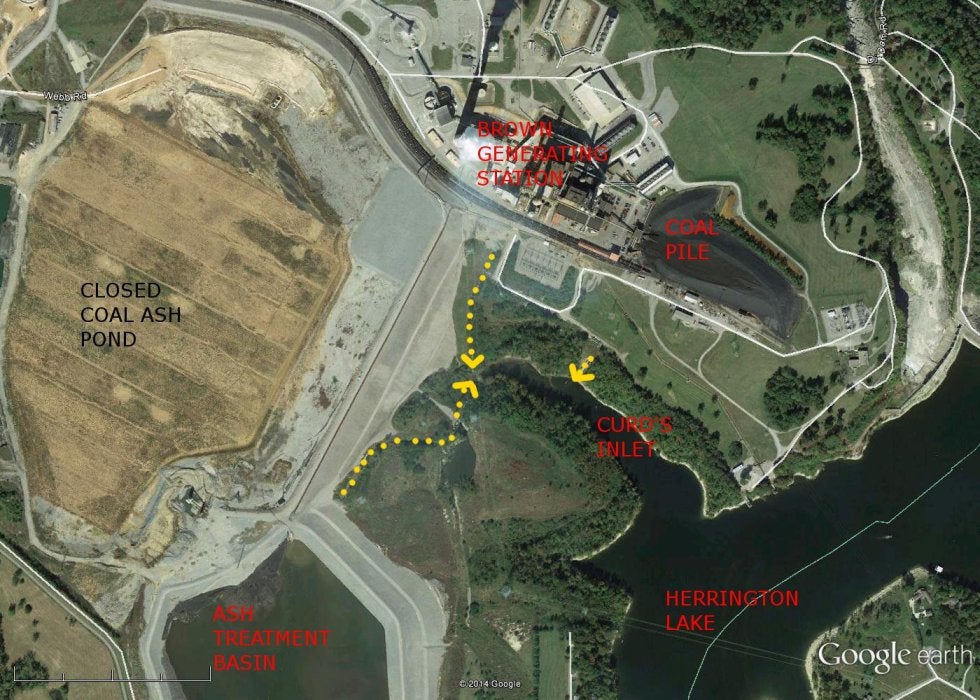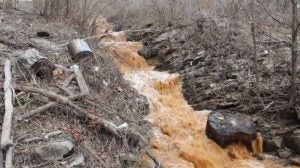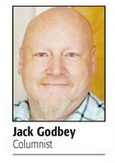Is there something fishy in Herrington Lake?
Published 7:29 am Saturday, November 18, 2017

- An edited aerial photo shows the size of the closed coal ash pond behind the E.W. Brown Generating Station on Herrington Lake in Mercer County. (Kentucky Waterways Alliance)
Kentucky Utilities wants a lawsuit over pollution from a coal ash pond dismissed. But an attorney for the plaintiffs says the energy company and state regulators are ignoring the problem and appear to be ‘working in close collusion.’
Editor’s note: This is the first part of a two-part investigative series looking into a battle over what to do about a toxic waste site at E.W. Brown Generating Station in Mercer County.
Kentucky Utilities has filed a request in Lexington federal court to dismiss a lawsuit filed against it back in July, on behalf of plaintiffs who want to see a toxic waste site cleaned up.
But an attorney for the plaintiffs says the energy company — and the state agency charged with regulating it — are ignoring the “canary in the coal mine,” and putting off real solutions to the problem of pollution seeping into Herrington Lake.
The site in question — where at least 6 million cubic yards of coal ash is buried — is located at E.W. Brown Generating Station, outside of Harrodsburg and almost to Burgin, in Mercer County. The lawsuit alleges the coal ash is polluting groundwater and Herrington Lake with toxic substances, including selenium.
The power plant is owned by KU Energy, which is owned by Louisville Gas & Electric and a subsidiary of PPL Corporation, based out of Louisville.
The facts
The power plant has burned coal since the 1950s; the ash pond in question was closed in 2008. An auxiliary pond is already lined and is slated to be closed in 2019, under an agreed-upon timeline with the state.

Kentucky Division of Waste Management (DWM) had employees on a site visit on Feb. 20, 2014. On the site visit, they recorded a video of a discharge occurring and noted a number of other hydrogeologically significant features and contaminated areas. (Photo courtesy of the Kentucky Waterways Alliance)
The utility company is permitted to emit acceptable wastes into Herrington Lake because of KPDES, the Kentucky Pollution Discharge Elimination System.
Almost four years ago, KU was being inspected, after already entering an agreement with the state to clean up contamination, and more evidence of pollution was found in the discoloration of lake water near the site.
Tests conducted by KU show contaminants such as arsenic, selenium and boron have gotten into groundwater, and other tests by the Kentucky Division of Water found that nine out of 10 fish samples collected near the plant had levels of selenium in violation of Kentucky water standards, and that arsenic levels were 98 times the level allowed.
A lawsuit was filed by Earthjustice, backed by the Sierra Club and the Kentucky Waterways Alliance. It cites lake residents listed as witnesses and outlines several reasons for the action, including that a public-comment process concerning a corrective action plan (CAP) submitted to the state by KU was “deficient and restricted, such that the public has neither been adequately informed about the CAP nor afforded full and fair opportunities to voice their concerns.”
The lawsuit also requests that water sampling to determine the extent of pollution should be more extensive and conducted in a shorter timeline, and it should focus on the sources of selenium impacts near the E.W. Brown site — not at various sites around the lake, as KU’s plan proposes. It says KU’s plan “relies on KU’s past groundwater assessment and remedial action plans,” which the environmental groups claim are “seriously deficient.” And the lawsuit requests the action plan tailor testing for the analysis of selenium, which is distinct from other pollutants.
KU requests dismissal because the state Energy and Environment Cabinet is in charge of addressing groundwater pollution and is already working with KU on the matter.
“The Cabinet has ordered and KU is implementing … comprehensive remedial measures designed to ensure the protection of human health and the environment,” the motion to dismiss reads. “Although Plaintiffs may disagree with the cabinet’s decisions regarding the appropriate remedial measures, they have failed to challenge them in accordance with the administrative appeal procedures established by state law.”
The attorney
“KU made the motion to dismiss our case on a number of different technical legal grounds,” says Thomas Cmar, an attorney with Earthjustice. Cmar says KU claims the court doesn’t have the power to order the company to do more than it’s already doing, or to make it submit to a study plan. “Our response was to urge the court to hear the case and move forward with it.”
When KU decided it needed to close its main ash pond, a cap was put on it, then the company attempted to contain it with an impervious covering, and on top of that a landfill was constructed. The cap is now the floor of the landfill.
Cmar says they’ve spent years — “… my organization, the Sierra Club and Waterways Alliance …” — back to 2013, raising the same issues about the pollution and the measurable impact on water quality and fish.
“Simply put, this is the canary in the coal mine that tells us something needs to be changed. We don’t think the company’s current efforts or study plans will result in any positive changes.”
Cmar says Kentucky Division of Water did put out a public notice asking for comments from citizens and organizations on the KU plan.
“We raised concerns with the study — KU is proposing several years of additional studies and sampling, lots of it upstream from the plant, not right beside it.”
Cmar says this doesn’t examine the problem — “To go upstream, and look for other potential contributors? Seems that they are inclined to find someone else to point the finger at.”
It’s absurd, Cmar says, to see what other facilities KU is proposing to sample areas of the lake around. “A home for elderly people, an auto shop … The idea (that) these types of businesses would be doing anything to meaningfully contribute to the contamination of Herrington Lake, when KU is the one who owns the power plant with 6 million yards of buried coal ash along the shore — they’d rather spend their own rate-payers’ money for these studies, to only divert attention.”
Cmar says another big issue is the way the state agency has handled this process.
“We asked them to make all of the relevant documents available to the public. There are people who live on the lake and want to participate and read them.”
Cmar says the state “put in place a whole series of barriers” preventing everyday residents from getting copies of all the documents, several which were not posted.
“They made you go through a website, and when you tried to select the link to download them, it asked for a password,” he says. “Only people who were on the state’s email list were given passwords. That’s fine for me; it’s my job to do it. But for folks who just live along the lake and want to know more about this problem … (they) shouldn’t have to get access to a website to get studies about water quality in their backyard.”
Cmar says the groups who filed suit asked the state to provide more time for comments, and about a month was given — not long enough, he says, for people who don’t normally deal in these types of documents and technical jargon to figure out what they’re looking at.
“We asked them for a public hearing or a meeting near the lake where people live, so they can learn more, and they refused to do that. They didn’t give us a reason for it,” Cmar says. “Obviously, our concern is that the state is working in close collusion with KU, and that KU does not want members of the public to know what’s going on in their own backyards, or to know just how bad the problem is, that this pollution is going into the lake and harming the fish.”
Cmar and others involved in the suit have been in touch with people who have written the state, who live in the community and have asked about a public meeting. He says the state hasn’t been responsive to any of those requests, either.
Cmar says the groups feel “pretty strongly that the lawsuit we’ve filed is the only way we’re going to break out of the log jam we’ve seen of raising concerns with the company and with the state repeatedly over the years about the company’s failure to sufficiently take steps to eliminate the ongoing pollution in the lake.
“We’ve spent many years identifying problems and the company has had every opportunity to address them, that’s why we’ve decided to go to court.”
Cmar says the utilities company has the ability to hire some of the best lawyers possible to make its filings.
“We’re part of a national alliance; we do work on this in different parts of the country. It’s a very specialized field. I wouldn’t necessarily say we’re David and they’re Goliath, but we’re often going up against companies that have more lawyers and more money than we do,” he says. “But this is particularly concerning because these expenses are going to be charged back to the ratepayers, almost certainly. That, I think, is a major concern for anyone who has to pay a utility bill. We shouldn’t be letting our utilities companies pollute our lakes and rivers with coal ash pollution because they don’t want to spend the money to generate the power cleanly.”
Cmar said he wants it clear: The corrective action plan in question was submitted by KU; it’s not a plan from the state telling KU what to do.
“The state has been going along with it. It’s looking in the wrong places and asking the wrong questions,” he says. “We know (the pollution is) coming from the coal ash, but there’s never been a study in detail about how it’s getting out. They’ve never done a serious effort to evaluate in order to do more.
“The core problem is that there is ground water flowing underneath the power plant, but it flows right back out into the lake. It’s cheaper for them to leave their 6 million yards of coal ash there, but as long as it’s sitting there, this will get worse.”
Cmar thinks residents who are concerned should be reaching out to the Division of Water. He says there’s no reason why a public meeting can’t be held with the state and KU on-hand to explain to residents what’s going on.
“And people should have an opportunity to express their concerns. The state should listen to people who live there, use it every day and cherish it. The state agency is supposed to be the place where people can go and get these questions answered, and the agency who makes sure their water is protected from pollution. People along the lake have the right to expect that.”
The state
Although the communications director and director for the Kentucky Division of Water both spoke back in July about the suit, they declined to be the ones answering questions this time around. After a few phone calls and emails, John Mura agreed to comment to The Advocate-Messenger. He is the communications director for the Kentucky Energy and Environment Cabinet.
Mura says the Division of Water has tentatively approved the initial site investigation phase of the plan.
“What that means is KU and LGE — their contractors are collecting samples. We have not gotten the results yet.”
Asked if it is normal to have a utilities company contract its own testing when there is a complaint against it concerning pollution, Mura could not confirm.
“I don’t have enough information to know what is normal in every circumstance. I will say that this is a process, and the process is playing out in a very orderly way.”
Mura was asked if scientific data already shows birth defects, deformations, slow growth and other problems in fish in the area directly linked to overexposure to selenium, why the state would not require KU to do something more drastic now, rather than later after things could get worse.
“We have followed the same protocol that we are required to follow. The protocol is to always characterize the nature to the extent of the issue. We have to have data. Until we have that data, we won’t know what the appropriate action to take or to develop is. That’s what we’re doing. We are strictly following our own protocol — it’s a process that’s been proven to be valuable and we are doing it.”
Mura says KU is overseeing the testing information, not the state.
“That is required by law. The responsible party is required by law to do the testing. We are required by law to oversee it.”
When asked how the state would oversee the testing, Mura said, “… When we get the tests back, we will analyze the sampling and determine whether it was adequate … We’ll analyze the testing and the way it was done.”
Mura was asked about unanswered requests by residents of the area to have some kind of public hearing or meeting, where the state and KU would be present to explain the corrective action plan and a timeline.
“Two things about this … Given the great public interest in this, we took the unusual step of inviting public comment early in the process. Secondarily, we will re-evaluate whether a public hearing is appropriate after a corrective action plan is developed. It’s been submitted, but not approved.”
When asked what the plan might be to stop the leakage of selenium and other dangerous elements and chemicals into the lake from the pond, Mura said he was told “there simply isn’t enough data right now to even speak about it. By the law, the responsible party has to do an investigation. We have Dr. (Dennis) Lemly’s results (submitted as court record by the suing parties) and we will give it due weight.”
Mura was asked about residents’ claims that it was difficult to get the relevant documents that, in theory, were made available to the public about the utility company’s submitted plan and testing that was done.
“I can’t speak to anything that happened then, however I can say that all public records are available to any citizen. All they have to do is ask for it. It is the practice that by law, we make all documents available upon requests. We’re happy to do that.”
Generally, Mura said, the cabinet asks a request to be submitted in writing. “Which is the law. That is the Open Records Law. And we follow the law.”
When asked about claims of the appearance of collusion between the state and KU, Mura said he wished he knew how to reassure people.
“I wish there was something I could say to reassure residents that in no way are we colluding with anyone, with KU or anyone else. We are doing due diligence with this. We are expecting that we will have a resolution, an action plan as quickly as we can that will address the situation. When we see what is proposed, we will have to approve it and be sure that it will remedy the situation.”






